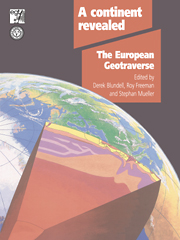2 - MOBILE EUROPE
Published online by Cambridge University Press: 05 November 2009
Summary
Present day Europe forms part of the large Eurasian plate which is surrounded by 12 large and at least as many small plates. This plate configuration, where curving Alpine fold belts and island arcs wind along the convergent borders, is relatively young, of Late Mesozoic–Cenozoic origin. In earlier geological times quite different plate configurations existed. Some of the former plate borders can still be recognised as deep scars, called sutures, in the continental crust, other plate borders have been obliterated. Because all the pre-Mesozoic oceans that once surrounded Europe have also been lost (consumed by subduction), the answers as to how Europe was formed and assembled must be sought in the continental lithosphere. To look for these answers was a prime aim of the European Geotraverse Project.
In this introductory review of Europe's tectonic evolution, we focus on when, where, and how the crystalline basement and folded cover sequences of Europe's Precambrian and Phanerozoic fold belt were formed and assembled. Europe's growth started about 3.5 Ga ago, in Archaean time, in the northeastern part of the Baltic Shield, and since then the growth continued episodically. Along the Geotraverse, the European crust becomes younger and younger, roughly speaking, in a southwards direction up to the present plate border at the Sardinian channel in the Mediterranean.
HOW FAR BACK DOES PLATE TECTONICS GO?
During the 1980s there was a growing recognition among geoscientists of the intimate relationship between plate tectonics and continental growth since early geological time.
- Type
- Chapter
- Information
- A Continent RevealedThe European Geotraverse, Structure and Dynamic Evolution, pp. 11 - 32Publisher: Cambridge University PressPrint publication year: 1992
- 51
- Cited by

